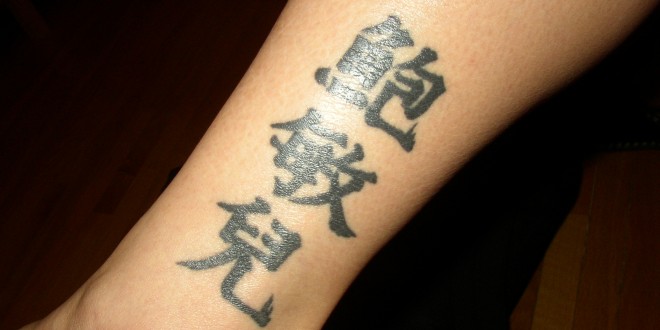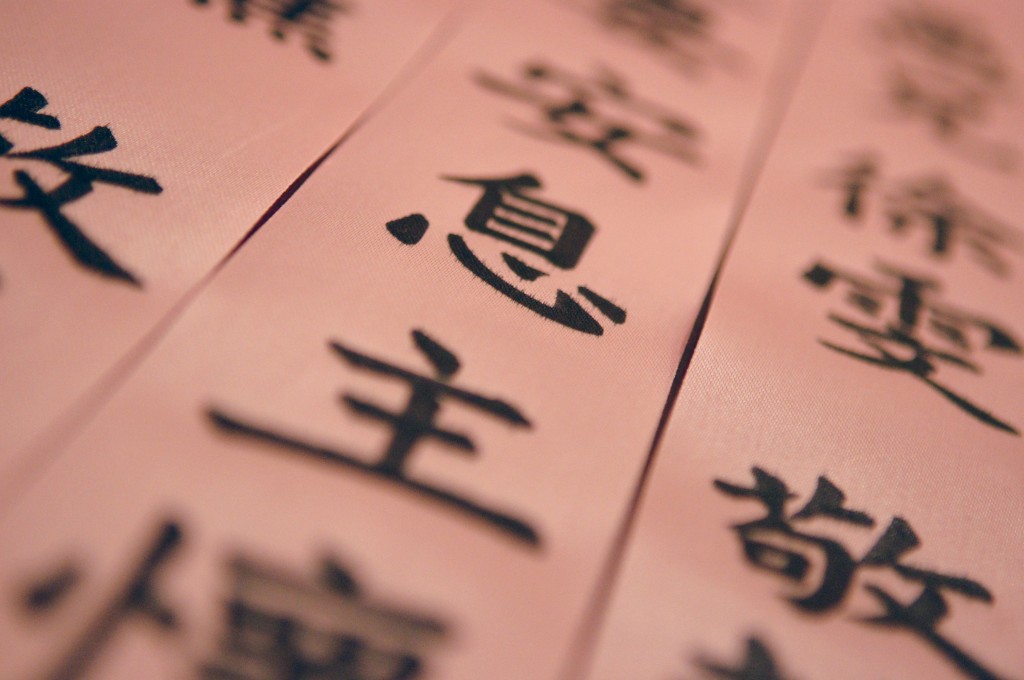Many tattoos are carriers of tiny tales and conveyers of messages. The tales and messages can be expressed as images, phrases, or words. Tattoos can be easy to read – a person’s name enclosed in a heart obviously means the wearer has (or had) affection for a certain person, so one’s heart can literally be worn – well, not on, but under one’s sleeve.
Or tattoos can be enigmatic and symbolic. This applies to foreign language tattoos, and especially Chinese language tattoos.
Angelina Jolie is a good example – the actress sports tattoos in different languages that relate to important events and people in her life. One tattoo is in Khmer, the language of Cambodia, and is an incantation to protect her and her adopted son Maddox, who comes from Cambodia, from bad luck. Where the Khmer tattoo now sits, Jolie used to have the Chinese character (kanji or hanzi) tattoo for “death” (si, 死) on her shoulder blade.
Whereas in China it is still not really part of mainstream culture to get a tattoo (certain ethnic minorities excepted, and members of organized crime or the underworld, or, as another expat bluntly told me while I was living in China, “gangsters and hookers”), Western celebrities have made it chic to get Chinese character tattoos. Take David Beckham, who has a saying from Confucius’ Analects running down his side, which reads in Chinese, “Life and death are decided by fate, wealth and honor are from heaven.” Meanwhile, Cher has the Chinese character 力 (li) inked on her right arm (“strength, power”).
I have seen the very same tattoo on a Caucasian man (he happened to be on probation from prison) who sported the Chinese word for “anger,” 火气 (huoqi). I also met an African American woman who had 美 (mei, “beautiful”) tattooed on her neck, and a youthful-looking grandmother from Colombia who had the Chinese character for “eternity,” 永 (yong) next to a double heart tattooed on the nape of her neck. She told me this symbolized the love between her and her daughter and that she thought the Chinese character better expressed the concept of eternity than an Egyptian symbol.
There is something magical about Chinese characters – after all, these were originally pictographs and are loaded with meaning. The man who had the Chinese character tattoo for anger told me he chose Chinese because it was “different” and “artistic.”
Some may be drawn to Chinese characters for aesthetic reasons, while others have a personal interest in the language and culture and therefore opt to use them. For instance, basketball player Marcus Camby got the tattoo “勉族” (mian, “to strive” and zu, “clan”) to express his work ethic and love for his family in Chinese because he was an avid fan of kung fu movies.
I was initially attracted to Chinese language tattoos for a variety of reasons. First, on a very superficial, skin-deep level, I am attracted to beauty (you may blame it on my being born in the Year of the Snake), and I spend as much money on what I consider to be “art” as some women do on shoes. Case in point: On EBay I have earned the reputation of being a relentless and aggressive bidder on antique oriental scroll paintings, and as I was running out of space at home where to hang or stash my artwork, using my own body to showcase some art didn’t seem like a bad idea at the time.
Second, in my current “hometown,” Houston, tattoos are very popular. I have lived and traveled to different places in the world (including China) and like to understand and absorb different parts of a local “culture.”
Moreover, I am fascinated by the concept of eternity or quasi-eternity and have respect for those who are willing to commit to anything and “take the plunge.” Finally, I like an occasional thrill – well, at least an imaginary one. Remember Frank Stockton’s short story “The Lady or the Tiger” you probably read in high school? An element of uncertainty can be absolutely thrilling.
To find out more about what was being offered in terms of Chinese language tattoos and to find out whether or not a tattoo would be for me, I went “mystery shopping” at different tattoo parlors here in Houston.
In the first shop, I saw a man reclining on a chair, bare-chested, getting tattooed. I cringed as I pictured myself in that chair instead, then discreetly averted my eyes and started browsing various designs, among them a lot of Chinese designs and characters: There were Chinese zodiac animals, virtues, “man/woman,” elements, but also some inelegant references to the female anatomy as well as “drunk maniac,” “naughty,” “bad girl/boy,” and “victory or death.”
The next shop I visited did not offer a lot of designs except a book with perhaps two lonely Chinese characters. The pony-tailed tattoo artist on duty, Tony, told me that it was his experience that “names, Buddha, koi, and quotes” were the most popular. The majority of his clients brought in their own designs.
At my third stop, I met Paul, who was half-Vietnamese and half-Chinese. His co-worker, Ray, called him a “master” of his art, and Paul indeed seemed very knowledgeable. “Tattoos are a science,” Paul told me, and to the wearer, a tattoo was comparable to “a piece of jewelry” – in other words, art.
Moreover (and this may sound strange to some) he told me there are people who not only regarded tattoos as a means of self-expression, but actually enjoyed the pain. Paul also said that more white-collar workers were getting tattoos, such as doctors and engineers, so what used to be a blue-collar pastime and passion was now being embraced by the upper middle class. Hmm, Paul, I thought, so nowadays tattoos are not necessarily a “trashy” art form, but can be a sophisticated “art” that appeals to a wide variety of people across different social strata.
Paul described how prison inmates used guitar strings filled with ink to do an in-house tattoo job, and that nautical stars used to be a test of an artist’s expertise because the artist would need to do straight lines. He believed that currently, “realism” was popular, with customers bringing in photos as tattoo designs. However, Paul also warned me of the dangers of a tattoo gone wrong, citing the example of those who had wanted tattoos of babies, which ended up looking like “aliens.”
At the next store, when I expressed interest in Chinese characters, I was handed a binder printed out in 2004 from the “Formosa Translation Service.” “I haven’t done a kanji character in the last six months – they used to be popular in the late 90’s,” one of the artists told me. (Note: I see a lot of young people sporting Chinese language tattoos, which indicates that they are still popular because they cannot have gotten them too long ago as most U.S. states require you to be at least 18).
Here is a selection of what you could get tattooed in Chinese characters, and some of the words made me chuckle:
“American dream”
“allergy”
“amnesty”
“address book”
“acid rain”
“Black Forest”
“centipede”
“double happiness”
“database”
“food chain”
“free will”
“headache”
“hacker” (Internet)
“human right”
“hot dog”
“laboratory”
“last judgment”
“politics”
“pollution”
“pope”
“quantum physics”
“radiation”
“remote control”
“secret agent”
“sin”
“termite”
“vampire”
“vanilla”
“vegetarian”
In sum, I noticed that the Chinese character designs found in the shops I visited expressed universal virtues, as well as ideas and concepts often discussed in Western culture, everyday words which make little sense outside of context (see the list above), or cuss words, as well as designs commonly associated with the East (zodiac animals, dragons, Buddha, etc.). As far as I could ascertain with my limited command of Chinese, the characters used at the shops I visited were correct – something which should never be taken for granted.
After visiting several tattoo parlors, my flirtation with getting a Chinese language tattoo (or any tattoo for that matter) was diminishing fast, and I came to the sad conclusion that I was not a suitable candidate for getting inked. Yes, I am a great friend of make-believe, “what if” scenarios and day-dreaming. There were glorious moments when I pictured myself flashing a Chinese language tattoo conveying some metaphysical yet deeply personal message on the small of my back that demonstrated my bravado, sort of like a “red badge of courage” – but when I tried to picture myself in “the chair” actually getting my tattoo, I just couldn’t do it.
If you are averse to risk-taking and your pain tolerance is low, perhaps tattoos are not for you. I have a friend who has a tattoo on her breast. She told me, “If you can bear a child, you can get a tattoo.”
It was the pain that proved to be the deal-breaker for me. I hate pain, shamelessly pop Advils when I have a headache, and am quick to sign up for laughing gas at the dentist’s because my pain threshold is incredibly low. Sorry, I am not a stoic.
Yet shopping around for a Chinese language tattoo taught me that getting a Chinese language tattoo requires a combination of common sense and research.
Because a single character in Chinese is often somewhat vague, it may be advisable to get two or more to express a concept – unless of course you are more interested in the aesthetic look of your tattoo. You can also explore different kinds of script. Caoshu, or cursive script, is artistic and flowing, but a bit hard to read, while kaishu, or regular script, is a lot simpler and easier to read.
Remember, if your tattoos are visible, you will be a walking museum. Some bitterly regret having signed up for the Chinese language tattoo adventure because they didn’t do their homework. There is a story circulated on the Internet about a young man who made headlines because of his poor choice of a tattoo parlor and artist. He wanted to have “love, honor and obey” tattooed on his arm, but was in for a terrible surprise when a waitress at a Chinese restaurant divulged the truth about his tattoo.
His tattoo actually read, “At the end of the day, this is an ugly boy.”
Getting a bad Chinese language tattoo can be a horrific experience, as this story illustrates, so consult a native speaker if you are getting a foreign language tattoo, and select an artist who is experienced in the language you wish to get a tattoo in.
There is a blog dedicated to “tatt-tastrophes” called the Hanzi Smatter Blog, which deals with “the misuse of Chinese characters in Western culture.” If you already have a Chinese language tattoo and are unclear about its meaning and not afraid of a rude awakening, or if you want to verify the meaning of your Chinese language tattoo design, you can consult Tian, who runs the blog.
Lastly, be prepared to spend money (large, well-executed tattoos can cost you several hours in the chair and several hundreds of dollars). As a sign in one of the tattoo parlors I visited reminded shoppers, “Good tattoos are not cheap. Cheap tattoos are not good.”
At the end of the day, make sure you get a beauty, not a beast of a tattoo.
 Asian Fortune Your source for all things Asian American
Asian Fortune Your source for all things Asian American

